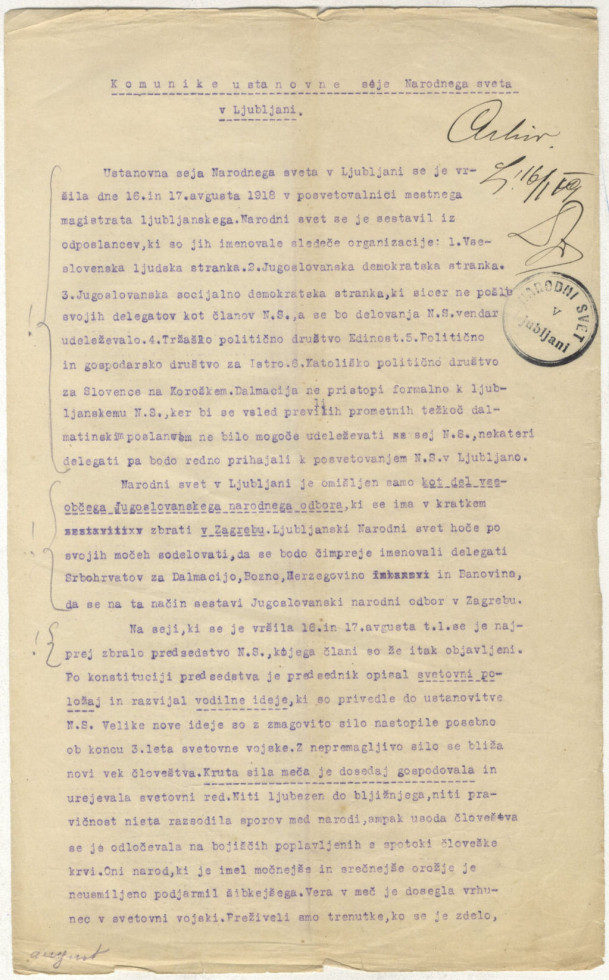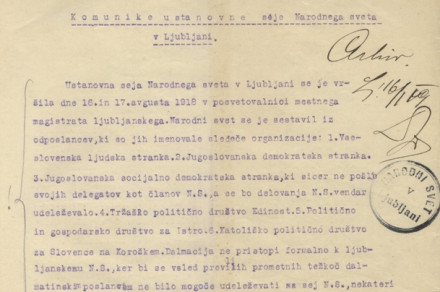Communique of the National Council's Founding Session
This year marks the centennial of the founding of the National Council in Ljubljana. Founded in August of 1918 as the highest ranking Slovenian political organization, its purpose was to make all the arrangements necessary for the joining of Slovenes with Croats and Serbs into a new, independent state. The National Council founded and organized local national councils and national guards and introduced Slovene as the official language. Divided into sections and subsections, it assumed power for the transitional period following the decision of its Constitutional-Administrative Section of October 28, 1918. After just a couple of days, on October 31, the Council handed over its administrative operations to the newly established National Government, while retaining and continuing to solve issues concerning the occupied Slovenian territories stretching from the Littoral to Prekmurje region, and particularly the issue of the Carinthian Plebiscite. The Presidency of the National Council established regional sections for Styria in Maribor, for Carinthia in Velikovec, and for the Littoral in Trieste and Gorizia. The national councils that had been active for the territory of the National Government of Slovenes, Croats and Serbs (SHS) in Ljubljana, except for the National Council in Ljubljana, which operated until April 1919, had already been disbanded on January 14, 1919, following the order of the National Government of SHS in Ljubljana (Official Journal of the National Government of SHS in Ljubljana, no. 36/19).
This month's archivalia presents the communique, i. e. official press release, of the founding session of the National Council in Ljubljana. The said document is kept among our archival records in the fonds SI AS 58, Slovenian National Council. The fonds in question comprises 6 archival boxes and two books and includes records of the financial, economic, rebuilding, and constitutional-administrative sections, as well as the records of the regional sections of the National Council for Styria and Carinthia, and the records of the purveyance subsection. Also preserved and kept at the Archives of the Republic of Slovenia are records of the National Council Borovlje (SI AS 36) and of the National Council for Carinthia in Velikovec (SI AS 660), which were transferred to Ljubljana after the Carinthian plebiscite of 1920.
The entire text of the communique was on August 28, 1918 published in the newsletter “Naprej” which was being issued by the Yugoslav Social Democratic Party. The founding of the National Council was enthusiastically reported on by almost every Slovenian newspaper of the time, starting with the newspaper “Slovenec”. The National Council was founded in the consultation hall at the Ljubljana Town Hall on August 16 and 17, and its establishment was based on the principles of the May Declaration (1917) and on President Wilson’s principle about the right to self-determination of peoples. The Trieste newspaper “Edinost” reported on the immense enthusiasm that was being generated in the capital city of Ljubljana in the anticipation of establishing this supreme authority of the Slovenian nation. The city was draped in tricolors, except of course for the palace of the Provincial Assembly. The celebrations in Ljubljana, attended also by the delegations of our fraternal Slavic peoples (Czechs, Poles), ended with the unveiling of the commemorative plaque in honour of Dr. Janez Evangelist Krek in the town of Šenjanž in Lower Carniola on August 18.
Established publicly and at widest and representative level, the National Council in Ljubljana was a political organization which united all political parties and set for its primary goal the joining of Slovenes and Istrian Croats with the rest of Croats and Serbs living in the monarchy, and later also the joining of the said nations in the same state with the rest of the Yugoslav people.
The delegates at the founding session were representatives of the most important political parties and organizations operating in the territory of the then Carniola, Styria, Carinthia and Littoral (Trieste and Istria): Pan-Slovenian People’s Party, Yugoslav Democratic Party, Yugoslav Social Democratic Party (the party did not actually have its own delegates at the founding session; they were subsequently appointed on November 11, 1918), the Trieste Political Association Edinost, Political and Economic Society for Istria, and Catholic Political Society for Slovenes in Carinthia. Due to poor traffic connections, representatives from Dalmatia did not join the National Council in Ljubljana.
At the founding session, which was also the first and the last plenary session, they elected and appointed the Presidency of the National Council in Ljubljana and Dr. Anton Korošec from the Pan-Slovenian People’s Party was appointed its president.
The National Council was in charge of the following tasks: to join Yugoslav nation into an independent state; to strive to achieve total equality of the Slovene language in administration, schools and public life in general; to protect, preserve and promote culture; to encourage joint economic interests and raise awareness about economic independence; to promote the Slovenian nation abroad.
To ensure smooth operation of the public life and efficient preparations for the establishment of a new state, the following sections of the National Council were formed: Organizational Section, Constitutional-Administrative Section, Propaganda Section, Protection of Interests Against the Existing Administration Section, Economic Concentration Section, “Jugopromet” Tourism Section, Regional Sections for Trieste, Istria, Gorizia region, Carinthia and Maribor, with possible subsection for the Prekmurje region, and Financial Sector. The National Council was in charge of the internal political and economic affairs, the fact confirmed also by the leadership of the National Council in Zagreb.
Also interesting was the relationship between the National Council and the National Government in October 1918. Basically it was a relationship between the parliament, i. e. legislative authority, and the government, i. e. executive authority. The National Council partly performed the function of the parliament, even though the representatives were not actually elected but appointed. A representative of the National Council also attended the sessions of the National Government and vice versa.
Branko Radulovič



